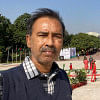Safety net schemes fall short in the fight against poverty

Social safety net programmes, such as Open Market Sales (OMS) and Vulnerable Group Feeding (VGF), provided less help to the actual poor, despite the government boasting about the impact of those schemes on reducing moderate and extreme poverty, according to a taskforce report.
The impact of those programmes was low because of an unclear focus, low benefits, and persistent targeting errors, the report, submitted to the interim government last week, said.
Using the 2022 Household Income and Expenditure Survey (HIES), the report estimated that social protection programmes contributed to reducing extreme poverty by only 0.6 percentage points and moderate poverty by 0.8 percentage points between 2010 and 2022.
"Most schemes fail to align with the core objective of addressing poverty, and the absence of robust income support measures leaves a critical gap in tackling both moderate and extreme poverty," it said.
Between 2010 and 2022, the poverty rate declined from 31.5 percent in 2010 to 18.7 percent in 2022, an average annual decline of 1.07 percentage points, according to the Bangladesh Bureau of Statistics (BBS).
Over the same period, extreme poverty followed a similar trajectory, dropping from 17.6 percent to 5.6 percent, an average annual decline of 1 percentage point.
The number of people in poverty declined from 4.54 crore in 2010 to 3.09 crore in 2022, while the corresponding fall in extreme poverty is estimated to have been from 2.53 crore to only 93 lakh, BBS data showed.
These outcomes could improve significantly if inclusion errors were corrected and resources reallocated to poor households, said the taskforce, which was formed on September 10 last year.
It was established to develop strategies to boost the economy and mobilise resources for equitable and sustainable development.
Those adjustments to poverty alleviation schemes, the report said, could increase the reduction in extreme poverty to 1.3 percentage points and moderate poverty to 2.5 percentage points.
Data from the 2022 HIES show that 53.9 percent of poor and vulnerable families are excluded from social protection programmes, mainly because of exclusion errors, while 62 percent of non-poor and non-vulnerable households receive some form of benefit because of inclusion errors.
CORRECTION EFFORTS ALSO FALL FLAT
To address the shortcomings of safety net programmes, the National Social Security Strategy (NSSS) was adopted in 2015, signalling a shift towards a structured framework grounded in the lifecycle approach.
The lifecycle approach means designing poverty alleviation policies and programmes that address the different vulnerabilities and needs people face at various stages of their lives, from childhood to old age.
The NSSS, which has seemingly well-defined reform objectives and time-bound action plans, is set to expire in June next year.
However, progress towards realising the NSSS vision has fallen significantly short of expectations, the taskforce report said.
Persistent issues, including structural inefficiencies, inadequate resource allocation, weak institutional capacities, and limited inclusivity, have hindered progress and undermined the system's effectiveness, the taskforce mentioned.
These shortcomings prevent vulnerable groups from escaping the cycle of poverty, thereby diminishing the overall impact of social protection programmes.
With the NSSS set to expire in June 2026 and many key reforms still unimplemented, its transformative potential remains unrealised.
For instance, programme fragmentation is still frequent, while progress in consolidating and harmonising poverty alleviation programmes is limited. Similarly, targeting errors in beneficiary selection continue to be pervasive.
Resource constraints exclude a substantial number of potential beneficiaries in all programmes, the small benefits provided without adjustments for inflation render the impact negligible, and a comprehensive and integrated database on social protection beneficiaries remains elusive, according to the report.
It said there has been virtually no progress in introducing interventions based on social insurance principles (such as unemployment insurance), while the capacities of different ministries and departments remain grossly inadequate, with persistent dependence on development partners.
"More strikingly, despite its emphasis, the system has evolved without a clear focus on addressing poverty effectively, and—given its current state of limited resources and meagre benefits—its role in dealing with inequality is highly questionable," the report mentioned.
SOCIAL PROTECTION GROSSLY OVERSTATED
The inclusion of numerous unrelated and irrelevant schemes in social protection allocations not only inflates the budget but also obscures the limited political commitment to addressing poverty and vulnerability, redirecting attention to the broader resource constraints faced by the country, the report said.
It said that social protection is grossly overstated because of the inclusion of schemes such as pensions for government employees, subsidies, interest payments on national savings certificates, and infrastructure development programmes.
Of the six largest schemes by budget allocation, only one—the old-age allowance—can be considered a genuine social protection measure.
Quoting government sources, it said social protection spending in fiscal year (FY) 2024–25 accounts for 2.5 percent of the gross domestic product (GDP) and 17 percent of the national budget.
However, when the programmes linked with pensions and subsidies are excluded, the allocation drops to only 1.2 percent of GDP and 7 percent of the budget.
The World Social Protection Report 2024–26, published by the International Labour Organization (ILO), estimated that Bangladesh spends just 0.9 percent of its GDP on social protection. This figure is markedly below the South Asian regional average of 3.8 percent.
On the other hand, social protection benefits in Bangladesh are low and are rarely adjusted for inflation, resulting in a steady erosion of their real value over time.
Estimates suggest that monthly benefits from key programmes, such as the old-age allowance (OAA) and widow allowance (WA), amount to just 14 percent of the national poverty line income per person, while the allowance for persons with disabilities is slightly higher at 22 percent.
This issue is further compounded by the lack of annual inflation adjustments for most regular benefit payments, which exacerbates the decline in their purchasing power, leaving them increasingly inadequate to address poverty and vulnerability effectively.
COVID EXPOSED FLAWS IN POVERTY FIGHT
Regarding the vulnerabilities in the safety net programmes, the report said their impact was starkly evident during the Covid-19 pandemic in 2020, when the resulting economic shocks pushed many individuals and families into poverty, giving rise to a group widely termed the "new poor".
It is estimated that the richest 5 percent of households in 2022 held 30 percent of the national income, while the poorest 5 percent were left with less than 0.4 percent.
Regularly adjusting transfer values for social protection programmes to account for inflation is crucial to ensuring their effectiveness in alleviating poverty. Many programmes in Bangladesh have failed to provide adequate benefits as allowances are not consistently reviewed in line with economic development and inflation.
Consequently, the real value of benefits has significantly declined over time, eroding their purchasing power. The NSSS has recommended inflation adjustments for all cash transfers under lifecycle-based core schemes to address this issue.
However, even with inflation adjustments, the real value of benefits for most programmes will remain insufficient, as initial benefit levels were too low to begin with.
To address this, it is critical that revised benefit levels are aligned with the minimum expenditure basket, enabling transfers to meaningfully alleviate poverty, said the taskforce.
A systematic review of transfer values should be conducted for all cash-based programmes, taking into account inflation, the expenditure basket, and the country's socio-economic progress.
Based on these reviews, adjustments should be implemented at regular intervals of two to three years to maintain the relevance and impact of social protection interventions, the report noted.


 For all latest news, follow The Daily Star's Google News channel.
For all latest news, follow The Daily Star's Google News channel. 





Comments